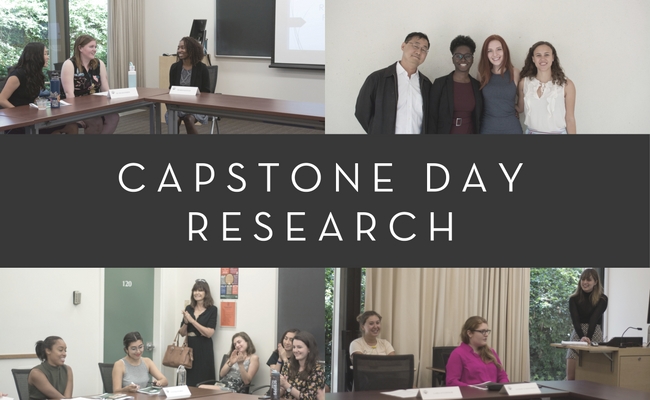
Each May, as seniors edge closer to graduation, the Scripps community takes a day to celebrate their academic achievements. Capstone Day, a Scripps tradition since 2008, brings the 5C community together to learn about outstanding senior thesis projects. Nominated by faculty, senior presenters share original projects in a range of disciplines and media—the culmination of the thinking, writing, and research they’ve been working on towards their degree.
Leonida Radford ’17, a biochemistry major on a premed track, was one of the more than 80 Capstone Day 2017 presenters. Her thesis investigated how the base-stacking phenomenon is crucial to DNA’s stability. “My research was an intersection of biology, chemistry, and physics, and it was a nice way to wrap up my four years [at Scripps],” she says. “Producing a senior thesis helped me explore how I learn best.”
For her thesis project, Stephanie Doan ’17, an Asian American studies major also on a premed track, conducted interviews that “shed light on the fact that physical health, sexual health, and mental health are often discussed in various realms but they all affect an individual’s wellbeing.”
“Being able to create new scholarship at an undergraduate level and better understand the complexities of healthcare in America and how to navigate healthcare as a minority…was really important to me, as there is not enough [published] literature about health issues that affect Vietnamese American women,” she says.
As a Chicanx/Latinx studies and Latin American studies major, Maya Salas ’17 looked at different teaching pedagogies folklòrico dance instructors use and examined how educators could incorporate some of those teaching methods within American educational curriculums, specifically for Chicanx and Latinx youth. Her thesis stemmed from an independent study she participated in while studying abroad in Bolivia and a class she took with Professor Martha Gonzalez.
“Unlike language that is dependent on both people speaking the same tongue, knowledge transmitted through the body is a way of knowing that is ingrained in how you move, feel, and think. My thesis explores these intersections of moving, feeling, thinking, and knowing.”
Thesis topics often stem from early experiences in students’ journeys at Scripps. “In my first year,” says Rachel Qi ’17, an economics and legal studies dual major, “I took an economics class with Professor Kerry Odell, and I loved it. She made everything very clear and interesting, so I continued to take economics courses. I also wanted to try law, so I took a couple legal studies courses, which I also liked. Being at Scripps, a liberal arts college, allowed me to take classes outside my major like psychology, philosophy, and music—[subjects] that gave me a very reaching experience.”
Thesis projects presented at Capstone Day not only showcase a broad range of topics in the humanities, STEM, and other interdisciplinary fields, but also represent the quintessential Scripps experience.
“I have grown so much as an individual the past few years, and being able to do a project that showed the value of being critical in ethnic studies and being intersectional in my work really highlighted that,” says Doan. “I never thought I would have the honor of presenting at Capstone Day, and it was a great opportunity to talk and share my thesis with the Scripps community.”
Here are some other highlights from Capstone Day 2017:
Taylor Carr-Howard ’17
The Cultural Mosaic Under the Tesserae: Local Identity in the Iconography and Compositions of Roman Floor Mosaics
This research showed how Roman floor mosaics demonstrated the values and behavior of the local viewers in the ancient cities of Antioch and Thysdrus. Carr-Howard identified compositional differences indicated different conceptions of the medium as well as locally specific iconography that tell the story of how these citizens lived within the broader context of the Roman Empire in the second and third centuries CE. “These images set the cities in context of—and help show responses to—Roman rule during those days,” she said.
Sharon Keenan ’17
Choreographic Exploration of Race and Gender Representation in Film and Dance
Keenan researched the impact that stereotypes and societal norms have had on people of color in the film and dance industries and beyond. “When people see these stereotypes reinforced in our industry, they believe they are true,” she said. She summarized her recommendations for upending traditionally reinforced limitations for people of color, including diversifying power structures, increasing financial support, and calling out problems of misrepresentation and exploitation when they occur.
Kathryn Read-Fisher ’17
One Size Fits No One: The Dramatic Truth About Size Discrimination in the Performing Arts
Read-Fisher’s research further informed her assessment that misrepresentation of overweight people in the performing arts is not only discriminatory, but also harmful, and is reinforced in many ways including roles and hiring practices. Her hope for the future is that roles for actors and other performers in the entertainment industry not be based on stereotypes related to weight or size. She said, “I’d like to see a day where we have great roles, played by great actors.”
Katie Shearer ’17
The “Postmodern Geographies” of Frank Gehry’s Los Angeles
Shearer, an art history major, presented on the impact of Frank Gehry’s architecture on the built and lived environment in Los Angeles. Identifying some of his most famous structures—his own private residence in Santa Monica, the Goldwyn Hollywood Regional Library Branch, and the Disney Concert Hall—she studied the impact his controversial style has had on the social, economic, and aesthetic makeup of the city.

